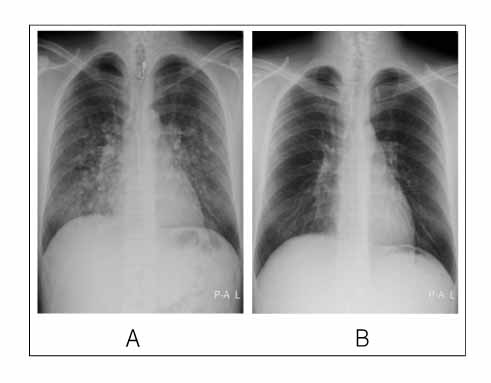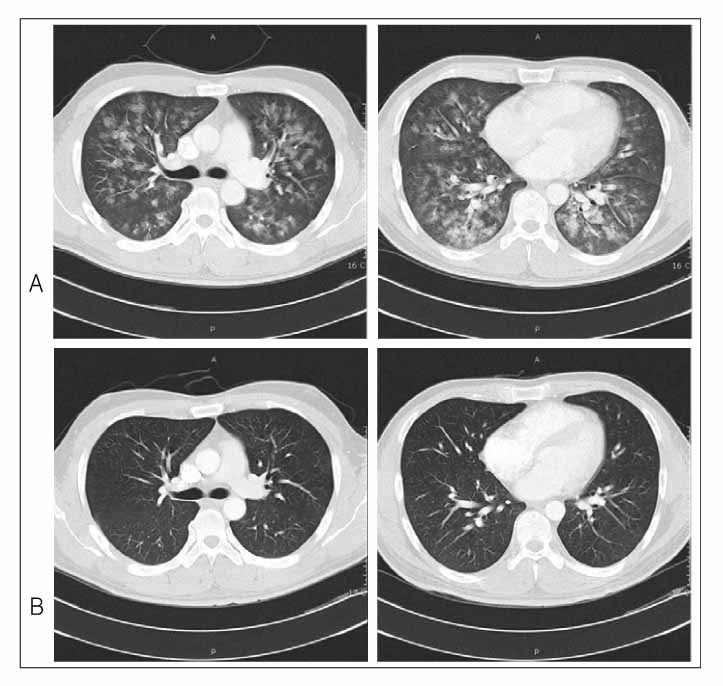Tuberc Respir Dis.
2007 Mar;62(3):223-226. 10.4046/trd.2007.62.3.223.
A Case of Acute Lung Injury Caused by Tetrafluoroethylene Inhalation
- Affiliations
-
- 1Department of Internal Medicine, Fatima Hospital, Daegu, Korea. leebk1@fatima.or.kr
- KMID: 1518468
- DOI: http://doi.org/10.4046/trd.2007.62.3.223
Abstract
- Tetrafluoroethylene is a colorless gas that can be used to synthesize a variety of fluoride compounds by polymerization (e.g., Teflon). Fluoride compounds have many applications in industry. There are several reports of inhalation injury from the pyrolytic product of fluoride compounds. When the polymer is heated under the conditions of inadequate ventilation, the fumes can cause polymer fume fever or pulmonary edema which manifested as symptoms such as fever, chill, profuse sweating, cough and dyspnea. However there are no reports of a direct lung injury caused by tetrafluoroethylene. We report a case of a 27-year-old male presented with acute lung injury after inhaling concentrated tetrafluoroethylene. He complained of cough and dyspnea after the accidental inhalation of tetrfluoroethylene at his workplace. The symptoms improved without any complications after conservative treatment with oxygen and steroid.
Keyword
MeSH Terms
Figure
Reference
-
1. NTP (National Toxicology Program). Toxicology and carcinogenesis studies of tetrafluoroethylene (CAS No. 116-14-3) in F344/N rats and B6C3F1 mice (inhalation studies). Natl Toxicol Program Tech Rep Ser. 1997. 450:1–321.2. Robbins JJ, Ware RL. Pulmonary edema from TEFLON fumes: report of a case. N Engl J Med. 1964. 271:360–361.3. Evans EA. Pulmonary edema after inhalation of fumes from polytetrafluoroethylene(PTFE). J Occup Med. 1973. 15:599–601.4. Harris DK. Polymer-fume fever. Lancet. 1951. 2:1008–1011.5. Okawa MT, Polakoff PL. Occupational health case reports: No.7. Teflon. J Occup Med. 1974. 16:350–355.6. Brubaker RE. Pulmonary problems associated with the use of polytetrafluoroethylene. J Occup Med. 1977. 19:693–695.7. Albrecht WN, Bryant CJ. Polymer-fume fever associated with smoking and use of a mold-release spray containing polytetrafluoroethylene. J Occup Med. 1987. 29:817–819.8. Lee CH, Guo YL, Tsai PJ, Chang HY, Chen CR, Chen CW, et al. Fatal acute pulmonary oedema after inhalation of fumes from polytetrafluoroethylene (PTFE). Eur Respir J. 1997. 10:1408–1411.9. Blanc PD. Mason RJ, Broaddus VC, Murray JF, Nadel JA, editors. Chapter 64. Acute pulmonary responses to toxic exposures. Murray and Nadel's textbook of respiratory medicine. 2005. 4th ed. Philadelphia: Elsevier Saunders;1823–1836.10. Martyny J, Rose C. Crapo JD, Glassroth JL, Karlinsky JB, King TE, editors. Chapter 43. Industrial hygiene for the pulmonologist. Baum's textbook of pulmonary diseases. 2004. 7th ed. Philadelphia: Lippincott, Williams & Wilkin;937–950.11. Caravati EM, Mcguigan MA, Whyte IM, Dawson AH, Seifert SA, Schonwald S, et al. Dart RC, editor. Part IV. Chemicals. Medical Toxicology. 2004. 3rd ed. Philadelphia: Lippincott, Williams & Wilkins;1129–1137. 1197–1198.12. Ip M, Wong KL, Wong KF, So SY. Lung injury in dimethyl sulfate poisoning. J Occup Med. 1989. 31:141–143.
- Full Text Links
- Actions
-
Cited
- CITED
-
- Close
- Share
- Similar articles
-
- A case of lung injury caused by ammonia-gas inhalation
- Two cases of acute lung injury caused by nitrogen dioxide inhalation
- A Case of Acute Lung Injury Caused by Inhalation of Industrial Acetic Acid
- Acute Chemical Pneumonitis Caused by Nitric Acid Inhalation: Case Report
- A Case of Pumpless Extracorporeal Interventional Lung Assist Application in a Patient with Severe ARDS Who Is Severe Burn with Inhalation Lung Injury: A Case Report



